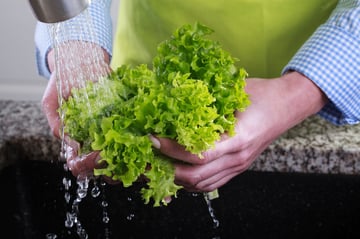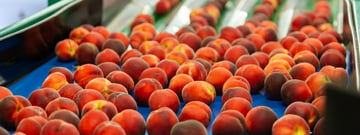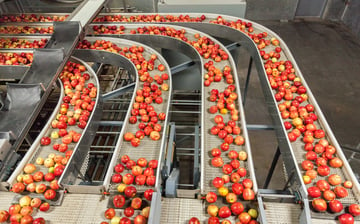Traceability is an incredibly relevant and powerful tool for organizations who deal with the manufacturing, production, and preparation of food. There are many benefits to an organization that’s truly traceable, but food safety is at the top.
Traceability Keeps Food Safe
Millions of people get sick each year from foodborne illnesses, many of whom are hospitalized. Most of the food contamination involved comes from growing, harvesting, manufacturing, packing, and shipping. It’s hard to monitor every aspect of this process, and sometimes food adulteration occurs.
Because of the high stakes that surround food production, the FDA requires - at minimum - that all food organizations have a one-up and one-back food traceability system to monitor the food supply and ensure safety. It’s part of the Food Safety Modernization Act (FSMA), and it makes food safety a responsibility of individuals in the supply chain, from growers to servicers. But one-up, one-back is table stakes. To unlock true ROI, you need an end-to-end food traceability platform.
When food is contaminated, it increases the risk for foodborne illnesses – one of the largest factors that demands traceability. Oftentimes, these illnesses can be totally prevented if the food sales entity or servicer makes sure it comes from a safe, clean environment before selling it.
Furthermore, the reduction of the illnesses that result in more than 5,000 deaths per year begins with fast identification of the food contaminant. For example, cases of salmonella are easier to fight if medical professionals can determine the source and the specific strain of bacteria. If food is traced effectively, this information can be made available to the FDA and applied to the illness at hand.
After the food issue is identified, nationwide recalls are sometimes administered. Even if a plant has only minor cases of foodborne illnesses to worry about, the organization can be required to send out a recall that will prevent others from becoming sick.
Recalls are very, very expensive. About 52 percent of recalls cost $10 million and 23 percent cost more than $30 million. This cost covers the consumer notification process, discarded product, consumer compensation, plant cleaning, and other processes necessary for eliminating the issue. In the past, we’ve covered 5 of the most common food recalls that brands might face.
When traceability software is involved, organizations can quickly identify the offending product and initiate a recall it before any extra product is produced. It can save an organization millions.
Traceability Enhances Food Quality and Transparency
The quality and transparency of food is a huge concern for consumers today. Thanks to the media and access to information regarding food contamination, consumers hold food quality to a much higher standard. Recalls are widely publicized, outbreaks and contaminations are front-page news, and political factors like GMOs and pesticides have people concerned about what’s in their food.
The ability to be totally transparent in front of consumers is one of the most important factors in the food production industry. When you use food tracking to monitor every step of your food, you can share the information with consumers and put their minds at ease.
Consumers today respond to transparent marketing more than anything else. The “farm-to-fork” movement is growing in popularity as consumers look for foods that are cleaner and less processed. You’ll attract a specific niche and enhance your audience. This is one of the best ways to score customer loyalty and build a reputation of offering quality products that consumers can trust.
Produce Traceability Initiative Urges Electronic Traceability
To some, it might seem a little redundant to make traceability a priority when you can clearly see the point of origin on the packaging label. Oranges grown in Florida and packaged by Sunkist will say so on the box, after all. For those further down the supply chain, the traceability of these oranges has already been monitored.
But not all food comes in neat little packages. Approximately 10-15 percent of our nation’s fruits, vegetables, and seafood comes from outside the country. Though FMSA strives to regulate imports, they’re not able to keep impeccable tabs on the movement of foods that cross their borders. With the right traceability resources in hand, it’s much easier to track fresh foods as they enter the country.
One important breakthrough in the process of improving traceability around the world is the Produce Traceability Initiative (PTI). This action enables a standardization food distribution for all food grown within the country and those coming from other nations.
Those who participate in this voluntary effort will use standardized traceability in every aspect of the supply chain, including growing, storing, packing and processing, distribution, transportation, etc. They also help to spread the word and use data to increase adoption of electronic traceability technology.
Though the FDA does not require that food growers, manufacturers, preparers, and sellers participate in this initiative, doing so can significantly help business. Many food-related businesses will refuse to do business with others if they aren’t involved in this traceability process.
FoodLogiQ Connect Makes Food Traceability Front and Center
Thanks to initiatives like PTI, we have electronic traceability programs like FoodLogiQ Connect. Through our tracking system, you can give consumers the transparency they look for in food products and services. You’ll be able to provide rich information for your marketing strategies that will offer a brand guarantee that consumers will love.
Brands like Subway/IPC have partnered with FoodLogiQ to show how the modern supply chain can be augmented with our software. They use the software to track their shipments and manage food from the farm all the way to the restaurant. FoodLogiQ makes it easy to create transparency and visibility across the entire supply chain.
Aside from quality features and ease of use, FoodLogiQ also helps you save valuable time and money. You’ll be able to manage all suppliers from a single application, giving you full visibility and guaranteed quality across the board. If there’s ever need for a recall, the speed and accuracy of FoodLogiQ’s system will help you catch the problem and rectify the situation, saving you millions.
Schedule My Free Demo
Other posts you might be interested in
View All Posts
Quality Management
5 min read
| May 23, 2018
Why You Need a Better Way to Investigate and Execute Recalls
Read More
Food Safety
3 min read
| September 28, 2022
What Can a Food Traceability System Do for Your Business?
Read More
Trustwell News
6 min read
| December 17, 2021

